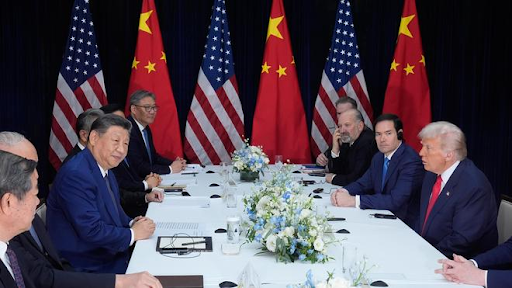



India and Australia are strengthening defence ties amid conditional U.S. security guarantees. The Comprehensive Strategic Partnership, Mutual Logistics Support Agreement, and exercises like AUSINDEX and AUSTRAHIND enhance interoperability. Cooperation in naval MRO, joint manufacturing, and MSME collaboration offers strategic opportunities, leveraging shared concerns over China’s assertiveness in the Indo-Pacific.

Copyright infringement not intended
Picture Courtesy: THE HINDU
India and Australia are boosting their defence partnership to enhance stability in the Indo-Pacific region.
Shared Vision
Both India and Australia want a stable and secure Indo-Pacific. Australia's strategic location connects the Indian and Pacific Oceans. This perfectly complements India’s "SAGAR" (Security and Growth for All in the Region) vision. (SAGAR is India's policy doctrine for maritime cooperation in the Indian Ocean region).
Both countries want to counter China’s increasing influence and help smaller Indo-Pacific nations build their own resilience.
Australia officially views India as a “top-tier security partner.” Its 2024 National Defence Strategy specifically emphasizes deepening defence cooperation with India and supporting India's regional leadership role.
Foundational Pillars
Comprehensive Strategic Partnership (CSP) (2020): This is the main umbrella agreement. It guides cooperation across many areas, including defence, trade, and technology.
2+2 Ministerial Dialogue (Launched 2021): The Foreign and Defence Ministers of both countries meet regularly. This allows for high-level strategic discussions and coordination.
Mutual Logistics Support Agreement (MLSA): It allows both militaries to use each other’s bases for things like fuel, repairs, and supplies during joint exercises or humanitarian aid missions. This makes working together much smoother.
Air-to-Air Refuelling Arrangement (2024): This agreement allows the Royal Australian Air Force (RAAF) to refuel Indian aircraft mid-air. This significantly extends the operational range and capability of India's air power.
Submarine Detection Technology Collaboration (2025): India and Australia agreed to collaborate on a towed array sonar project (advanced systems dragged behind ships or submarines to detect other submarines with greater accuracy and range).
India's MRO Proposal: India has offered to provide ship maintenance, repair, and overhaul (MRO) services for Australian naval vessels. This signals India’s growing expertise in this critical maritime sector.
Building Joint Capabilities
AUSTRAHIND (Army): An annual exercise, held alternately in India and Australia. Focuses on "sub-conventional operations" (like counter-terrorism) in semi-urban and desert environments.
AUSINDEX (Navy): A biennial (every two years) maritime exercise. The first was in Visakhapatnam (2015); the fifth in Sydney (August 2023). Focuses on maritime interoperability, anti-submarine warfare, and joint naval tactics.
Pitch Black (Air Force): A multilateral air combat exercise hosted by Australia. The Indian Air Force participates. This helps India’s air capabilities by exposing its pilots to complex coalition operations.
Malabar (Navy): A quadrilateral naval exercise involving India, Australia, the U.S., and Japan (the Quad). The 2024 edition was in the Bay of Bengal.
Break Service Silos (Integrate Army, Navy, Air Force)
While Navy-to-Navy cooperation is good, the Army and Air Force need more joint engagement.
Conduct joint exercises involving all three services that simulate real-world operations.
Establish a dedicated forum for "joint staff talks" (discussions between senior officers from all services).
Strengthen India's Diplomatic/Defence Presence in Canberra
Upgrade India’s Defence Adviser position in Canberra to a "one-star rank" (e.g., Brigadier, Commodore, Air Commodore).
Add dedicated Army and Air Force personnel as assistants to this Defence Adviser.
Appoint specific personnel to focus on engagement with Pacific Island nations, aligning with Australia's efforts there.
Encourage Ground-Up Innovation & Discussions
Strategic dialogues need more input from military professionals with on-ground experience.
Create secure channels for "classified exchanges" (sharing sensitive information).
Initiatives like fellowships for staff college graduates and regular "war-gaming exchanges" (simulated conflict scenarios) can build better understanding.
Boost Maintenance, Repair, and Overhaul (MRO) Cooperation
India has proven MRO capabilities (e.g., servicing U.S. and British Navy ships).
Collaborate with Australia on MRO for its naval vessels.
Jointly manufacture patrol boats for small island nations in the Indian Ocean and Pacific.
India's deal with France for Rafale-M jets, which includes setting up MRO facilities in India, as a possible model for Australia.
Reset Defence Industry Collaboration (Focus on MSMEs)
Many large defence companies (OEMs) in Australia are just branches of foreign firms.
The real potential lies with Micro, Small, and Medium Enterprises (MSMEs) in both countries. These smaller companies are often at the forefront of new technologies, components, and "dual-use technologies" (tech with both civilian and military uses).
Align India's and Australia's "indigenisation" programs (efforts to build defence equipment domestically).
Create similar as the U.S.-India INDUS X model to promote innovation between startups and MSMEs. (INDUS X is a U.S.-India initiative to connect defence startups and industries of both countries).
India and Australia can build a resilient defence relationship by using their Comprehensive Strategic Partnership (CSP), expanding exercises, and especially by collaborating in the MSME sector. This partnership can reduce their dependence on U.S. security guarantees.
Must Read Articles:
Source:
|
PRACTICE QUESTION Q. In what ways can India and Australia collaborate to address climate change while ensuring sustainable development in the Indo-Pacific region? 150 words |




© 2026 iasgyan. All right reserved